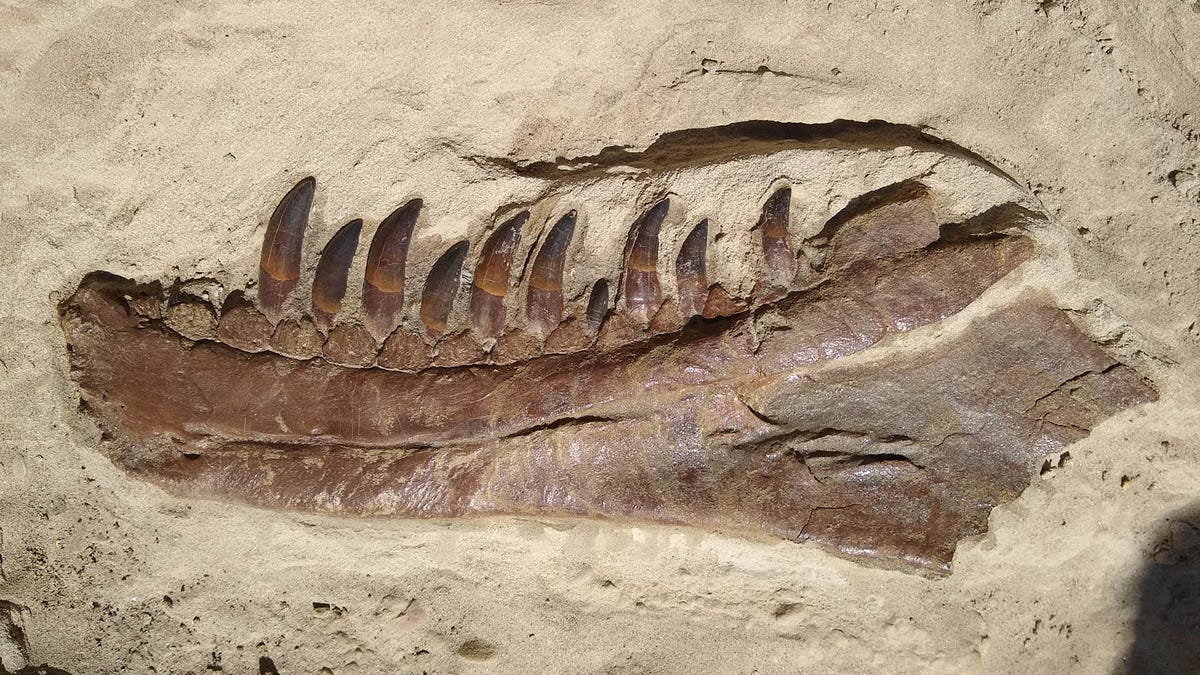76 Million-Year-Old Fossil Settles Paleontology Debate Over T. Rex History
This specimen, nicknamed "Sisyphus," was extremely difficult to nudge out of its resting place.

The spectacular lower jaw of the holotype skull had most of the teeth preserved in their sockets
Ask anyone to name three dinosaurs in five seconds, and I guarantee you Tyrannosaurus rex will make the list. Whether it's due to Jurassic Park or humanity's deep obsession with ancient predators, T. rex has become a cultural icon.
Yet despite the level of detail we have about this tiny-armed reptile itself, scientists surprisingly don't know much about the rest of T. rex's family. A wealth of questions remain about the ancestral tree that sprouted this vicious, quintessential dinosaur -- though paleontologists with the Badlands Dinosaur Museum in North Dakota say we may have some answers, at last.
In a paper published Nov. 25 in the journal Paleontology and Evolutionary Science, paleontologists Elias Warshaw and Denver Fowler report the discovery of a 76.5 million-year-old fossil that they believe belonged to one of T. rex's ancestors, a species now known as Daspletosaurus wilsoni.
An artist's rendering of D. wilsoni. Check out the unique arrangement of little horns under the dino's eyes.
And this dinosaur, expected to have lived during the Cretaceous period, seems to have been just as ferocious as its famous descendant.
D. wilsoni -- which literally translates to "Wilson's frightful reptile," after John P. Wilson who found the specimen to begin with -- likely once had expended air pockets in its skull, a blue-grayish coloring, a set of sharp teeth and an elongated eye socket -- rimmed with horns.
But in short, locating this species is a big deal for scientists because its existence could provide the "missing link" in T. rex's family backstory, bridging a longstanding gap between older and younger tyrannosaur species named Daspletosaurus torosus and Daspletosaurus horneri, which lived about 77 to 75 million years ago, respectively.
"Since the 1990s," Warshaw and Fowler wrote in a statement, "debate has surrounded Daspletosaurus, a large tyrannosaurid known from Montana and Alberta, which has been proposed to be an ancestor of T. rex itself."
But according to the statement, reconstructing the evolutionary relationships of Daspletosaurus has been hampered by the rarity of good specimens, and many researchers are still engaged in debate as to whether these tyrannosaurids represent a single lineage evolving in place or several closely related species from various lineages.
"We can now see that many of these species are actually very finely separated in time from each other," the statement reads, "forming consecutive ladder-like steps in a single evolutionary lineage where one ancestral species evolves directly into a descendant species."
The team even named its fossil find "Sisyphus," after the mythical Greek king who was punished for cheating death. As the tale goes, Sisyphys' punishment was to roll a giant boulder up a hill only for it to roll back down the hill every time he got close to the top. This seemingly horrid endeavor lasted for an eternity.
"The holotype skull and partial skeleton, BDM 107, is nicknamed 'Sisyphus' after the seemingly endless task of removing over 25 feet (8 meters) of rock which lay on top of the bones," the researchers said.
The paleontology team digging for remnants of D. wilsoni had to remove 25 feet of rock before a skeleton was revealed.
It was Badlands Dinosaur Museum crew member Wilson who spotted the skeleton in the first place in 2017 -- a small, flat piece of bone was peeking out from the bottom of a towering cliff. Upon close examination, that little bit of evidence turned out to be part of the dinosaur's nostril. And so the dig began, culminating in 2021 with an exquisite Tyrannosaurus-type animal figure.
"These findings," the researchers said, "suggest that previous research was correct in identifying several species of Daspletosaurus as a single evolving lineage, and supports the descent of T. rex from this group."

